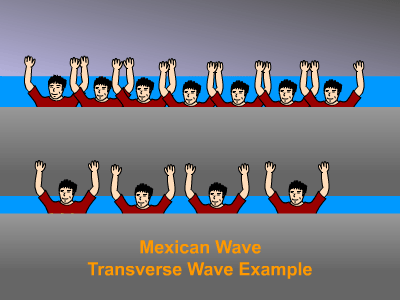Introduction
Waves are everywhere! In the air, in water, even in solid objects, visible and invisible, waves carry information – sometimes useful (like speech or TV data) and sometimes purely incidental (waves in the sea, or noise in the street).
Visible waves are probably the easiest to think about, and many types of mechanical oscillation generate visible waves. Have a look at the example below: a group of people jump up and sit back down, in sequence.

Note something travels from left to right in the animation (or around the stadium in the video). But the people themselves only stand up and sit down. No-one swaps seats. Here the medium in which the wave propagates is ‘people’. Without people there can be no Mexican waves. The wave is mechanical. No electrical, optical or acoustic stuff is happening, just a physical movement. In general, mechanical waves are transmitted by vibrating particles (in this case the particles are the people), but although they oscillate (stand up / sit down) the particles do not move from their normal position.
Transverse Waves
In the Mexican wave example, the movement of the people is vertical (up and down) whereas the wave travels horizontally (from left to right). This is a transverse wave – the vibration direction is perpendicular (at right angles) to the direction in which the wave travels or propagates. Transverse waves are very common, with waves in water and on guitar strings being two common examples.
Below is a particle model of a transverse wave. These particles could be metal molecules in a solid vibrating plate, or water molecules showing ripples traveling across a pond.

Animation: Daniel A. Russell The Pennsylvania State University
You can setup a clear transverse wave with a long piece of rope…lay it out along the ground, and flick one end rapidly up and down. This doesn’t work so well if someone holds the other end and you stretch it, as a higher tension in the rope means the wave speed is too high (it moves too fast) and it’s hard to see what’s going on. Check out the high-speed video below, and you’ll see what happens when we slow things down.